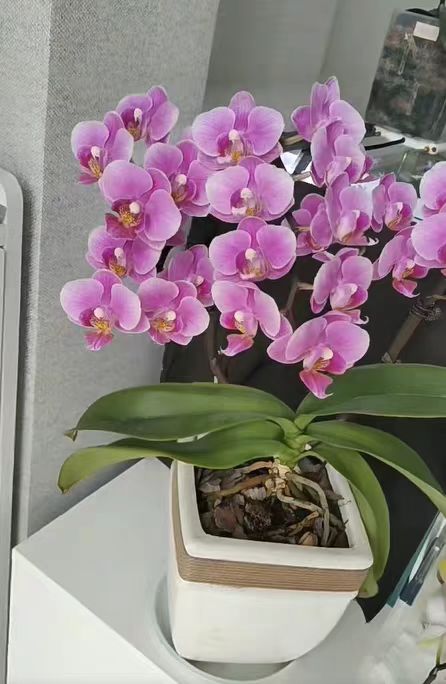As an epiphytic plant, the roots of a Phalaenopsis orchid not only perform the functions of absorbing nutrients and water but also participate in photosynthesis. Correctly judging whether the roots are short of water is a key skill in the cultivation of Phalaenopsis orchids. Understanding the manifestations of water shortage in Phalaenopsis orchids enables timely water replenishment to maintain the healthy growth of the plants.
Judging the water - deficient state by observing the appearance of the roots:
Color change of the roots: The roots of a healthy and well - hydrated Phalaenopsis orchid usually appear plump white or have a greenish sheen. This is because there is a layer of tissue called the "velamen" on the surface of the roots, which is rich in chlorophyll and shows a vivid color when there is sufficient water. When the roots lack water, the velamen gradually loses water and the color becomes dull. The white roots turn gray - white, and the green parts fade to gray - green. In severe cases of water shortage, they may even turn brown or black. This color change directly reflects the water status of the roots and is an important basis for judging whether there is a water shortage.
Change in the root morphology: The roots of a Phalaenopsis orchid with sufficient water are plump, firm, and elastic in texture. Gently touching them with your hand, you can feel their toughness. However, water - deficient roots will shrink due to cell water loss, becoming shriveled, soft, and even showing sunken lines, losing their original plump shape. Especially for the roots wrapped in water - retaining planting materials such as sphagnum moss, when you push aside the planting material to observe the root morphology, if you find that the roots are no longer round and plump, you should be alert to the problem of water shortage.
Leaves are the main organs for plants to carry out photosynthesis and are also important indicators reflecting the water status of plants. When a Phalaenopsis orchid lacks water, the leaves will lose their original fullness and become soft and limp. Especially the old leaves are more prone to becoming soft when lacking water.
In addition to becoming soft, the leaves of a water - deficient Phalaenopsis orchid may also show wrinkles or yellow edges. This is because the leaves cannot maintain their normal shape and structure when lacking water, resulting in morphological changes. At the same time, long - term water shortage will also lead to the degradation of chlorophyll at the leaf edges, causing the appearance of yellow edges.
Water shortage will seriously affect the growth rate of Phalaenopsis orchids. In a water - deficient state, the growth of Phalaenopsis orchids will slow down or even stop. This is because water is one of the important substances for plant cell division and growth, and water shortage will hinder cell division and growth.
For a flowering Phalaenopsis orchid, water shortage will also lead to a shortened flowering period. Water shortage will affect the opening and duration of the flowers, causing the flowers to wither prematurely. Therefore, in the management of the flowering period of Phalaenopsis orchids, it is of crucial importance to maintain sufficient water.
Mastering the methods of observing the water shortage of Phalaenopsis orchid roots and timely identifying various manifestations of water shortage are important prerequisites for ensuring their healthy growth. By carefully observing the appearance of the roots, the state of the leaves, and the condition of the planting material, the water requirements of the plants can be accurately judged, providing appropriate water maintenance for Phalaenopsis orchids.
How to tell if the roots of a Phalaenopsis orchid are lacking water?

Share with
Tagged in :




Leave a Reply